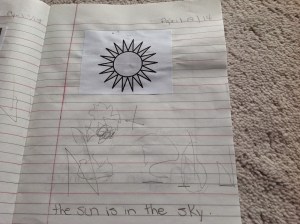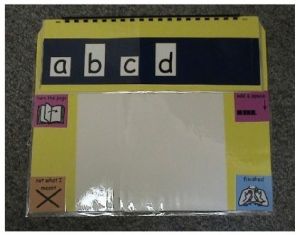Tip of The Month October 2014- Early Writing for Emergent Communicators
Early Writing for Emergent Communicators
As we know, there are many skills required to become a successful writer. Some of these include: understanding the purpose of communicating an idea in text, planning and expanding on this idea and physically producing some text so that it can be understood by an audience.
When we think about an emergent writer in the first years at school, they may go through the following steps to learn and develop these skills.
- Be a part of multiple shared writing sessions with the whole class where the teacher talks about the purpose of the writing piece and models some early skills.writing without standards
- Draw a picture to shape ideas and link to experiences.
- Talk about their picture with an adult or their peers in order to plan their text.
- Attempt to write. This may include some approximations of letters, some known initial sounds, some personal core words (Mum, Dad, own name) and this will develop and change as he or she is given multiple opportunities to write.
- Read and review.

In the first year at school, typical learners “may ‘write’ by making purposeful marks that are not recognisable as letters or words.” (Ministry of Education, 2014)
Some of the students we work with will have great difficulties with some of these steps. Drawing a picture, talking about an idea, connecting with real life experiences, writing letters to make words can be huge barriers for some people.
EVERYBODY can learn to write! It is our job to adapt and modify an activity so that our students can access literacy. As a part of a balanced literacy approach, you can follow similar steps for learners with emergent communication and literacy skills. Here’s how:
- Daily opportunities to see and hear examples of writing: recounts, lists, instructions, signing in, story writing.
- Drawing a picture. It may be important for our students to have a link to an experience or idea. This may be in the form of a remnant or item (a movie ticket, chippie packet), a photo or creating their own novel picture using something like ‘fuzzy felts’ (see links below for a quick guide).

- Talk about your idea. If the student has any kind of communication system or tool (communication book or board, single message device, high-tech device), use it. Model how you could talk about the picture. This could be as simple as pointing to one or two key words, or building a more complex sentence. Think about the level your student is at with their language and extend this a little to model. Accept attempts to comment or talk about their picture and use this as a start to the written text “You said ‘CAR’. You could say ‘I went in the car.’”

- Attempt to write. Remember; writing is communicating a message in text NOT the physical act of forming letters. If we remove the need to handwrite or even type letters and words and become a scribe, we are immediately increasing our students’ ability to engage in early attempts at writing. You could use keyboard, alt pencilan alphabet card or an alphabet flipchart (see links below for more information) to remove this huge barrier. Your student may access this alternative pencil by pointing at letters, eye-point or selecting as you scan through them. This is not the time to be testing or teaching letter sounds or spelling. While you may help with some phonological prompts, this is a time for your student to write freely and without constraints. Think about your emergent writer having the opportunity to scribble.
- Read and review the text. You read your student’s attempt at writing and reinforce any correct sounds or letters. “You wrote ‘bbbccccce’. I can see a ‘c’ for car. This is how I would write ‘car’.”
References and links:
http://uniquecurriculum.blogsp...
http://bridgesconference2010.c...
http://www.talklink.org.nz/wp-...
http://www.literacyprogression...
Ministry of Education. (2014). The Literacy Learning Progressions. Retrieved from
Early Writing for Emergent Communicators
As we know, there are many skills required to become a successful writer. Some of these include: understanding the purpose of communicating an idea in text, planning and expanding on this idea and physically producing some text so that it can be understood by an audience.
When we think about an emergent writer in the first years at school, they may go through the following steps to learn and develop these skills.
- Be a part of multiple shared writing sessions with the whole class where the teacher talks about the purpose of the writing piece and models some early skills.writing without standards
- Draw a picture to shape ideas and link to experiences.
- Talk about their picture with an adult or their peers in order to plan their text.
- Attempt to write. This may include some approximations of letters, some known initial sounds, some personal core words (Mum, Dad, own name) and this will develop and change as he or she is given multiple opportunities to write.
- Read and review.

In the first year at school, typical learners “may ‘write’ by making purposeful marks that are not recognisable as letters or words.” (Ministry of Education, 2014)
Some of the students we work with will have great difficulties with some of these steps. Drawing a picture, talking about an idea, connecting with real life experiences, writing letters to make words can be huge barriers for some people.
EVERYBODY can learn to write! It is our job to adapt and modify an activity so that our students can access literacy. As a part of a balanced literacy approach, you can follow similar steps for learners with emergent communication and literacy skills. Here’s how:
- Daily opportunities to see and hear examples of writing: recounts, lists, instructions, signing in, story writing.
- Drawing a picture. It may be important for our students to have a link to an experience or idea. This may be in the form of a remnant or item (a movie ticket, chippie packet), a photo or creating their own novel picture using something like ‘fuzzy felts’ (see links below for a quick guide).

- Talk about your idea. If the student has any kind of communication system or tool (communication book or board, single message device, high-tech device), use it. Model how you could talk about the picture. This could be as simple as pointing to one or two key words, or building a more complex sentence. Think about the level your student is at with their language and extend this a little to model. Accept attempts to comment or talk about their picture and use this as a start to the written text “You said ‘CAR’. You could say ‘I went in the car.’”

- Attempt to write. Remember; writing is communicating a message in text NOT the physical act of forming letters. If we remove the need to handwrite or even type letters and words and become a scribe, we are immediately increasing our students’ ability to engage in early attempts at writing. You could use keyboard, alt pencilan alphabet card or an alphabet flipchart (see links below for more information) to remove this huge barrier. Your student may access this alternative pencil by pointing at letters, eye-point or selecting as you scan through them. This is not the time to be testing or teaching letter sounds or spelling. While you may help with some phonological prompts, this is a time for your student to write freely and without constraints. Think about your emergent writer having the opportunity to scribble.
- Read and review the text. You read your student’s attempt at writing and reinforce any correct sounds or letters. “You wrote ‘bbbccccce’. I can see a ‘c’ for car. This is how I would write ‘car’.”
References and links:
http://uniquecurriculum.blogsp...
http://bridgesconference2010.c...
http://www.talklink.org.nz/wp-...
http://www.literacyprogression...
Ministry of Education. (2014). The Literacy Learning Progressions. Retrieved from
